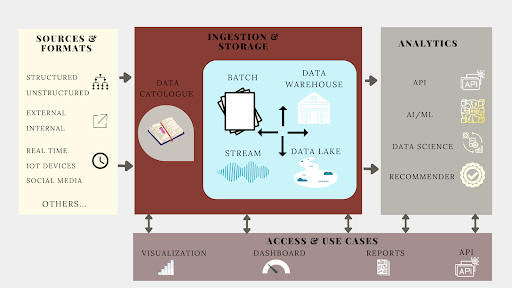Data architecture maps the structure of an organization’s data and how the data flows to serve business objectives. Designing effective data architecture requires knowledge of both data needs and business processes.
Data modeling and data strategy go hand-in-hand with data architecture.
Data modeling works at the micro level. The models take care of the specific rules of certain data in a database and how to organize it, whereas data architecture addresses the macro level. The architecture offers a holistic perspective of all data in the business. Think of it like this: IKEA furniture often comes with an instruction brochure. The instructions correspond to the data modeling and tell you exactly how all the pieces fit together, while the furniture blueprint corresponds to the data architecture, which gives you a birds-eye view of the project.
Meanwhile, data strategy relates to the data’s overall vision and framework. The strategy lays out guidance on data governance and policies, while the data architecture itself serves as the data strategy’s foundation.
Why Is Data Architecture Important?
Organizations should have solid data architecture to support their business needs. Well-designed and updated data architectures enable organizations to:
- Better understand data needs and align those needs with business requirements.
- Develop sustainable and adaptable logical data structures to meet the organization’s future needs.
- Aid in data management and governance.
- Improve data quality and consistency.
- Serve as a foundation for the company’s data strategies.
- Help reduce data storage and processing costs by understanding the nature of data and its actual value.
How Does Data Architecture Work?
In the past, simple data architecture has served organizations well. It used to be easy to map out a simple data architecture with a single database using extract, transform and load (ETL) processes. However, data architectures are becoming more complex. Advances in cloud computing, machine learning and data proliferation present new challenges. For example, real-time data analytics and pipelines increase the complexity of data architectures. Companies now deal with such high-speed data that architectures must be able to handle spikes of data volumes when required.
It’s important to remember that organizations must update data architectures as data and business needs shift. New technological breakthroughs might also demand revisions to data architecture.
Data Architecture Example
Data comes from different sources and also in various forms. Let’s take a look at a simple example of data architecture and its structure.

The architecture should map out the sources of the data and formats (e.g., internal vs. external sources, structured vs. unstructured data). The next layer deals with data ingestion and storage. The data catalog binds together the organization’s data; the catalog matches the data source’s needs to the type of storage and processing the data requires. For example, a data lake stores low-performant unstructured data while a data warehouse holds data in a structured format that can serve consumers. The analytics layer can aid in data processing with data science tools (see figure above). Finally, users should be able to access what they need, for example, data visualization and reports.
Data Architecture Framework
Organizations can adapt standard architecture frameworks, which lay out the principles and standards to develop the data architecture roadmap. One of these frameworks is The Open Group Architecture Framework (TOGAF). The TOGAF framework has a specific architecture development method (ADM) section, which describes how to develop and manage enterprise architecture. TOGAF also highlights architectural best practices. When organizations adopt architectural frameworks like the TOGAF, they can follow standard procedures and best practice guidelines to create high-quality data architectures that cater to their needs.
What Are the Risks of Weak Data Architecture?
Rapid technological advances and changes in business needs can undermine effective data architectures. When we add new lines and shapes to a data architecture’s data flow, it becomes very difficult to keep them updated and consistent. This can lead to duplicate data processes, high costs and increased maintenance time for business. Organizations should strive to balance the complexity of data architectures, business needs and the new tools/platforms for data management by carefully adopting new technologies that align with their vision and goals.





